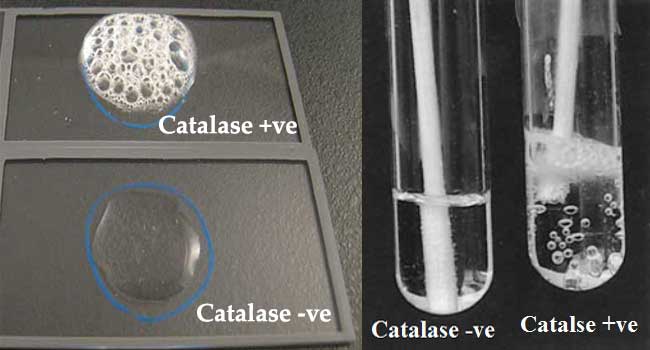Catalase Test- Principle, Uses, Procedure, Result Interpretation with Precautions

This test demonstrate the presence of catalase, an enzyme that catalyses the release of oxygen from hydrogen peroxide (H2O2). It is used to differentiate those bacteria that produces an enzyme catalase, such as staphylococci, from non-catalase producing bacteria such as streptococci. Normally 3% H2O2 is used for the routine culture while 15% H2O2 is used for detection of catalase in anaerobes.
Principle of Catalase Test
The enzyme catalase mediates the breakdown of hydrogen peroxide into oxygen and water. The presence of the enzyme in a bacterial isolate is evident when a small inoculum is introduced into hydrogen peroxide, and the rapid elaboration of oxygen bubbles occurs. The lack of catalase is evident by a lack of or weak bubble production. The culture should not be more than 24 hours old.
Bacteria thereby protect themselves from the lethal effect of Hydrogen peroxide which is accumulated as an end product of aerobic carbohydrate metabolism.
Purpose or Uses of Catalase Test
- The morphologically similar Enterococcusor Streptococcus (catalase negative) and Staphylococcus (catalase positive) can be differentiated using the catalase test.
- Also valuable in differentiating aerobic and obligate anaerobic bacteria.
- Semiquantitative catalase test is used for the identification of Mycobacterium tuberculosis.
- It is used to differentiate aerotolerant strains of Clostridium, which are catalase negative, from Bacillus species, which are positive.
- Catalase test can be used as an aid to the identification of Enterobacteriaceae.
Procedure of Catalase Test
Tube Method
- Pour 1-2 ml of hydrogen peroxide solution into a test tube.
- Using a sterile wooden stick or a glass rod, take several colonies of the 18 to 24 hours test organism and immerse in the hydrogen peroxide solution.
- Observe for immediate bubbling.
Slide Method
- Use a loop or sterile wooden stick to transfer a small amount of colony growth in the surface of a clean, dry glass slide.
- Place a drop of 3% H2O2 in the glass slide.
- Observe for the evolution of oxygen bubbles.
Result Interpretation of Catalase Test and Examples

Positive: Copious bubbles produced, active bubbling
Examples: Staphylococci, Micrococci, Listeria, Corynebacterium diphtheriae, Burkholderia cepacia, Nocardia, the family Enterobacteriaceae (Citrobacter, E. coli, Enterobacter, Klebsiella, Shigella, Yersinia, Proteus, Salmonella, Serratia), Pseudomonas, Mycobacterium tuberculosis, Aspergillus, Cryptococcus, and Rhodococcus equi.
Negative: No or very few bubbles produced.
Examples: Streptococcus and Enterococcus spp
Quality Control of Catalase Test
Positive: Staphylococcus aureus– ATCC 33592
Negative: Enterococcus faecalis– ATCC 29212
Precautions of Catalase Test
- The test organisms should not be taken from blood agar culture. Red Blood cells contain catalase and their presence will give a false positive test.
- Culture should be 18 to 24 hours old.
- Hydrogen peroxide must be fresh as it is very unstable.
- Iron wire loop should not be used.
- Some bacteria produce a peroxidase that catalyzes a breakdown of hydrogen peroxide causing the reaction to be weakly positive; (a few bubbles elaborated slowly). This should not be confused with a truly positive reaction.
- Do not add organism to reagent, particularly if iron-containing inoculating loops are used. Iron containing loops will cause false positive test results if exposed to hydrogen peroxide.
Similar Posts:
- Oxidase Test- Principle, Uses, Procedure, Types, Result Interpretation, Examples and Limitations
- PYR Test- Principle, Uses, Procedure and Result Interpretation
- Microdase Test – Principle, Procedure, Uses and Interpretation
- Widal Test- Introduction, Principle, Procedure, Interpretation and Limitation
Categories Biochemical Test
21 thoughts on “Catalase Test- Principle, Uses, Procedure, Result Interpretation with Precautions”
Hi;
I have a question. My micoorganisma is E.coli, S. aureus, P. aureginosa, E. facialis and C. albicans. I want to catalase test. Which one should I choose as a concentration?(concentration %30, %15 or %3). Thank you for answer. I used 3% h2o2 for E. coli, but no air bubbles appeared. Why ? Reply
Shuba Ali Adamu
How do I conclude on the catalase test on microorganisms Reply
VICTOR KIPCHUMBA
+Ve(positive)…if bubbles are produced ( provided you used the asceptic method of placing the test microbe colony on a drop of hydrogen peroxide on the glass slide -ve(negative) if no bubble at all is produced or very few[tiny] bubbles are produced. Reply
Oluwadunsin Ololade
The wire loop is made of nickel, a metal. It can therefore react with the hydrogen peroxide to give a false result.
Generally, a metal should not be used because of its ability to react with metal. Reply



